Spatial and Temporal Variability of Permafrost in the Western Part of the Russian Arctic
Abstract
:1. Introduction
2. Materials and Methods
3. Climate
4. Results and Discussion
4.1. Active Layer Thickness (ALT)
4.2. Thermal State of Permafrost
4.3. Sensitivity of Permafrost Region to Climate Change
4.4. Dynamic Maps of Temperature of Permafrost
5. Conclusions
Author Contributions
Funding
Institutional Review Board Statement
Informed Consent Statement
Data Availability Statement
Acknowledgments
Conflicts of Interest
References
- Pavlov, A.V. Permafrost-climatic monitoring of Russia: Analysis of field data and forecast. Polar Geogr. 2008, 31, 27–46. [Google Scholar] [CrossRef]
- Brushkov, A.V.; Buldovich, S.N.; Volokhov, S.S.; Garagulya, L.S.; Komarov, I.A.; Koshurnikov, A.V.; Kuchukov, E.Z.; Motenko, R.G.; Nesmelova, E.I.; Ospennikov, E.N.; et al. Osnovy Merzlotnogo Prognoza Pri Inzhenerno-Geologicheskikh Issledovaniyakh (Fundamentals of Permafrost Forecasting in Engineering and Geological Research); Geoinfo: Moscow, Russia, 2016; p. 512. [Google Scholar]
- Blunden, J.; Boyer, T. State of the climate in 2020. Bull. Am. Meteorol. Soc. 2021, 102, S1–S475. [Google Scholar] [CrossRef]
- Biskaborn, B.K.; Smith, S.L.; Noetzli, J.; Matthes, H.; Vieira, G.; Streletskiy, D.A.; Schoeneich, P.; Romanovsky, V.E.; Lewkowicz, A.G.; Abramov, A.; et al. Permafrost is warming at a global scale. Nat. Commun. 2019, 10, 264. [Google Scholar] [CrossRef] [PubMed] [Green Version]
- Vasiliev, A.A.; Drozdov, D.S.; Gravis, A.G.; Malkova, G.V.; Nyland, K.E.; Streletskiy, D.A. Permafrost degradation in the Western Russian Arctic. Environ. Res. Lett. 2020, 15, 045001. [Google Scholar] [CrossRef]
- Kaverin, D.; Malkova, G.; Zamolodchikov, D.; Shiklomanov, N.; Pastukhov, A.; Novakovskiy, A.; Sadurtdinov, M.; Skvortsov, A.; Tsarev, A.; Pochikalov, A.; et al. Long-term active layer monitoring at CALM sites in the Russian European North. Polar Geogr. 2021, 44, 203–216. [Google Scholar] [CrossRef]
- Izrael, Y.A.; Pavlov, A.V.; Anokhin, Y.A. Evolution of the cryolithozone under present-day global climate changes. Russ. Meteorol. Hydrol. 2002, 1, 14–24. [Google Scholar]
- Pavlov, A.V.; Malkova, G.V. Sovremennye Izmeneniya Klimata na Severe Rossii (Contemporary Changes of Climate in Northern Russia); Geo: Novosibirsk, Russia, 2006; p. 54. [Google Scholar]
- Streletskiy, D.; Anisimov, O.; Vasiliev, A. Permafrost degradation. In Snow and Ice-Related Hazards, Risks, and Disasters; Shroder, J.F., Haeberli, W., Whiteman, C., Eds.; Academic Press: Boston, MA, USA, 2015; pp. 303–344. [Google Scholar] [CrossRef]
- Romanovsky, V.; Isaksen, K.; Drozdov, D.; Anisimov, O.; Instanes, A.; Leibman, M.; McGuire, A.D.; Shiklomanov, N.; Smith, S.; Walker, D.; et al. Changing Permafrost and its Impacts. In Snow, Water, Ice and Permafrost in the Arctic (SWIPA) 2017; Arctic Monitoring and Assessment Programme: Oslo, Norway, 2017; pp. 65–102. [Google Scholar]
- Vasiliev, A.A.; Gravis, A.G.; Gubarkov, A.A.; Drozdov, D.S.; Korostelev, Y.V.; Malkova, G.V.; Oblogov, G.E.; Ponomareva, O.E.; Sadurtdinov, M.R.; Streletskaya, I.D.; et al. Degradatsiya merzloty: Rezul’taty mnogoletnego geokriologicheskogo monitoringa v zapadnom sektore rossiiskoi Arktiki (Permafrost degradation: Results of long-term geocryological monitoring in the Western sector of Russian Arctic). Kriosf. Zemli 2020, 24, 15–30. [Google Scholar]
- Streletskiy, D.A.; Sherstiukov, A.B.; Frauenfeld, O.W.; Nelson, F.E. Changes in the 1963–2013 shallow ground thermal regime in Russian permafrost regions. Environ. Res. Lett. 2015, 10, 125005. [Google Scholar] [CrossRef]
- Dubrovin, V.A.; Brushkov, A.V.; Drozdov, D.S.; Zheleznyak, M.N. Izuchennost, sovremennoe sostoyanie, perspektivy i problemy osvoeniya kriolitozony Arktiki (Study, current state, future and challenges of development of permarost in the Arctic). Miner. Resur. Rossii. Ekon. Upr. 2019, 55–64. [Google Scholar]
- Shur, Y.; Goering, D.J. Climate change and foundations of buildings in permafrost regions. In Permafrost Soils; Margesin, R., Ed.; Springer: Berlin/Heidelberg, Germany, 2009; pp. 251–260. [Google Scholar] [CrossRef]
- Drozdov, D.S.; Malkova, G.V.; Ukraintseva, N.G.; Korostelev, Y.V. Permafrost monitoring of southern tundra landscapes in the Russian European North and West Siberia. In Proceedings of the Tenth International Conference on Permafrost (TICOP). Resources and Risks of Permafrost Areas in a Changing World, Salekhard, Russia, 25–29 June 2012; pp. 65–70. [Google Scholar]
- Frolov, A.V. (Ed.) Second Roshydromet Assessment Report on Climate Change and Its Consequences in Russian Federation. General Summary; Federal service for Hydrometeorology and Environmental Monitoring (Roshydromet): Moscow, Russia, 2014; p. 54.
- Brown, J.; Hinkel, K.M.; Nelson, F.E. The Circumpolar Active Layer Monitoring (CALM) program: Research designs and initial results. Polar Geogr. 2000, 24, 166–258. [Google Scholar] [CrossRef]
- Romanovsky, V.E.; Drozdov, D.S.; Oberman, N.G.; Malkova, G.V.; Kholodov, A.L.; Marchenko, S.S.; Moskalenko, N.G.; Sergeev, D.O.; Ukraintseva, N.G.; Abramov, A.A.; et al. Thermal state of permafrost in Russia. Permafr. Periglac. Processes 2010, 21, 136–155. [Google Scholar] [CrossRef]
- Blunden, J.; Arndt, D.S. State of the climate in 2018. Bull. Am. Meteorol. Soc. 2019, 100, Si-S306. [Google Scholar] [CrossRef] [Green Version]
- Vasiliev, A.A.; Oblogov, G.E.; Streletskaya, I.D.; Fedin, V.A.; Shirokov, R.S.; Zadorozhnaia, N.A. Thermal regime of the upper part of permafrost in the transition zone from land to sea, Western Yamal. Earth’s Cryosphere 2017, 21, 28–35. [Google Scholar] [CrossRef]
- Malkova, G.V. Monitoring srednegodovoi temperatury porod na statsionare Bolvanskii (Mean-annual ground temperature monitoring on the steady-state-station “Bolvansky”). Kriosf. Zemli 2010, 14, 3–14. [Google Scholar]
- Malkova, G.V.; Korostelev, Y.V.; Sadurtdinov, M.R.; Skvortsov, A.G.; Tsarev, A.M. Modern climatic changes and temperature regime of permafrost rocks of the European North. In Proceedings of the Rasshirennoe Zasedanie Nauchnogo Soveta po Kriologii Zemli RAN “Aktual’nye Problemy Geokriologii” (Open Session of the Scientific Committee on the Earth’s Cryology of the Russian Academy of Sciences “Urgent Challenges in Geocryology”), Moscow, Russia, 15–16 May 2018; pp. 98–104. [Google Scholar]
- Malkova, G.V.; Vasiliev, A.A.; Gravis, A.G.; Drozdov, D.S.; Korostelev, Y.V.; Ponomareva, O.E. Vozdeistvie sovremennykh klimaticheskikh izmenenii na temperaturnyi rezhim merzlykh tolshch rossiiskoi Arktiki (The impact of modern climatic changes on the temperature regime of the frozen strata of the Russian Arctic). In Proceedings of the Vserossiiskaya Konferentsiya, Posvyashchennaya 60-Letiyu Obrazovaniya Instituta Merzlotovedeniya im. P.I. Mel’nikova SO RAN “Ustoichivost’ Prirodnykh i Tekhnicheskikh Sistem v Kriolitozone” (Russian Conference on the Occasion of the 60th Anniversary of the Melnikov Permafrost Institute “Environmental and Infrastructure Integrity in Permafrost Regions”), Yakutsk, Russia, 28–30 September 2020. [Google Scholar]
- Malkova, G.V.; Vasiliev, A.A.; Gravis, A.G.; Drozdov, D.S.; Sadurtdinov, M.R.; Skvortsov, A.G.; Tsarev, A.M. Prostranstvennaya i vremennaya izmenchivost’ merzlykh tolshch v zapadnom sektore Rossiiskoi Arktiki—Rezul’taty kompleksnogo monitoringa na geokriologicheskikh statsionarakh (Spatial and temporal variability of permafrost in the Western sector of the Russian Arctic—Results of complex monitoring at geocryological sites). In Proceedings of the Sovremennye Issledovaniya Transformatsii Kriosfery i Voprosy Geotekhnicheskoi Bezopasnosti Sooruzhenii v Arktike (Cryosphere Transformation and Geotechnical Safety in the Arctic), Salekhard, Russia, 8–12 November 2021; pp. 279–282. [Google Scholar]
- Ponomareva, O.E.; Drozdov, D.S.; Gravis, A.G.; Berdnikov, N.M.; Bochkarev, Y.N.; Ustinova, E.V.; Leshnevskaya, E.F. Features of permafrost degradation at the southern border of the cryolithozone (according to the results of monitoring in Western Siberia). In Proceedings of the Rasshirennoe Zasedanie Nauchnogo Soveta po Kriologii Zemli RAN “Aktual’nye Problemy Geokriologii” (Open Session of the Scientific Committee on the Earth’s Cryology of the Russian Academy of Sciences “Urgent Challenges in Geocryology”), Moscow, Russia, 15–16 May 2018; pp. 189–195. [Google Scholar]
- Drozdov, D.S.; Vasiliev, A.A.; Malkova, G.V.; Moskalenko, N.G.; Orekhov, P.T.; Ukraintseva, N.G. Izmeneniya temperatury mnogoletnemerzlykh porod zapadnogo sektora Rossiiskoi Arktiki v svyazi s izmeneniyami klimata (Temperature changes of permafrost rocks of the western sector of the Russian Arctic in connection with climate changes). In Polyarnaya Kriosfera i Vody Sushi (Polar Cryosphere and Continental Waters); Kotlyakov, V.M., Ed.; Paulsen Editions: Saint-Petersburg, Russia, 2011; pp. 153–170. [Google Scholar]
- Orekhov, P.T.; Popov, K.A.; Slagoda, E.A.; Kurchatova, A.N.; Tikhonravova, Y.V.; Opokina, O.L.; Simonova, G.V.; Melkov, V.N. Frost mounds of Bely island in coastal marine settings of the Kara Sea. Earth’s Cryosphere 2017, 21, 41–51. [Google Scholar] [CrossRef]
- Mel’nikov, V.P.; Trofimov, V.T.; Orlov, V.P.; Brushkov, A.V.; Drozdov, D.S.; Dubrovin, V.A.; Pendin, V.V.; Zheleznyak, M.N. Prinyatie doktriny izucheniya i okhrany “vechnoi merzloty”—Neobkhodimyi element strategii razvitiya AZRF (Adoption of the doctrine on study and protection of permafrost—The necessary element of the strategy of development of the Arctic Zone of the Russian Federation). In Proceedings of the Rasshirennoe Zasedanie Nauchnogo Soveta po Kriologii Zemli RAN “Aktual’nye Problemy Geokriologii” (Open Session of the Scientific Committee on the Earth’s Cryology of the Russian Academy of Sciences “Urgent Challenges in Geocryology”), Moscow, Russia, 15–16 May 2018; pp. 6–19. [Google Scholar]
- Kukkonen, I.T.; Suhonen, E.; Ezhova, E.; Lappalainen, H.; Gennadinik, V.; Ponomareva, O.; Gravis, A.; Miles, V.; Kulmala, M.; Melnikov, V.; et al. Observations and modelling of ground temperature evolution in the discontinuous permafrost zone in Nadym, north-west Siberia. Permafr. Periglac. Processes 2020, 31, 264–280. [Google Scholar] [CrossRef]
- Obu, J.; Westermann, S.; Bartsch, A.; Berdnikov, N.; Christiansen, H.H.; Dashtseren, A.; Delaloye, R.; Elberling, B.; Etzelmüller, B.; Kholodov, A.; et al. Northern Hemisphere permafrost map based on TTOP modelling for 2000–2016 at 1 km2 scale. Earth-Sci. Rev. 2019, 193, 299–316. [Google Scholar] [CrossRef]
- Westermann, S.; Østby, T.I.; Gisnås, K.; Schuler, T.V.; Etzelmüller, B. A ground temperature map of the North Atlantic permafrost region based on remote sensing and reanalysis data. Cryosphere 2015, 9, 1303–1319. [Google Scholar] [CrossRef] [Green Version]
- Nicolsky, D.J.; Romanovsky, V.E. Modeling Long-Term Permafrost Degradation. J. Geophys. Res. Earth Surf. 2018, 123, 1756–1771. [Google Scholar] [CrossRef]
- Cable, W.L.; Romanovsky, V.E.; Jorgenson, M.T. Scaling-up permafrost thermal measurements in western Alaska using an ecotype approach. Cryosphere 2016, 10, 2517–2532. [Google Scholar] [CrossRef] [Green Version]
- Biskaborn, B.K.; Lanckman, J.P.; Lantuit, H.; Elger, K.; Streletskiy, D.A.; Cable, W.L.; Romanovsky, V.E. The new database of the Global Terrestrial Network for Permafrost (GTN-P). Earth Syst. Sci. Data 2015, 7, 245–259. [Google Scholar] [CrossRef] [Green Version]
- Sudakova, M.S.; Sadurtdinov, M.R.; Tsarev, A.M.; Skvortsov, A.G.; Malkova, G.V. Ground-penetrating radar for studies of peatlands in permafrost. Russ. Geol. Geophys. 2019, 60, 793–800. [Google Scholar] [CrossRef]
- Sudakova, M.; Sadurtdinov, M.; Skvortsov, A.; Tsarev, A.; Malkova, G.; Molokitina, N.; Romanovsky, V. Using Ground Penetrating Radar for Permafrost Monitoring from 2015–2017 at CALM Sites in the Pechora River Delta. Remote Sens. 2021, 13, 3271. [Google Scholar] [CrossRef]
- Sadurtdinov, M.R.; Skvortsov, A.G.; Tsarev, A.M.; Sudakova, M.S.; Malkova, G.V. Geophysical methods for studying the thickness of the melt layer and its properties at CALM sites (European North). In Proceedings of the Vserossiiskaya Knferentsiya, Posvyashchennaya 60-Letiyu Obrazovaniya Instituta Merzlotovedeniya im. P.I. Mel’nikova SO RAN (Russian Conference on the Ocassion of the 60th Anniversary of the Melnikov Permafrost Institute “Environmental and Infrastructure Integrity in Permafrost Regions”), Yakutsk, Russia, 28–30 September 2020; pp. 421–424. [Google Scholar]
- Sadurtdinov, M.R.; Skvortsov, A.G.; Sudakova, M.S.; Tsarev, A.M.; Malkova, G.V. Ispol’zovanie seismicheskikh i georadiolokatsionnykh metodov v geokriologicheskikh issledovaniyakh (Seismic and ground penetrating radar methods in permafrost research). Vestn. Sev.-Vostochnogo Nauchnogo Tsentra DVO RAN 2017, 75–86. [Google Scholar]
- Skvortsov, A.G.; Sadurtdinov, M.R.; Tsarev, A.M.; Dubrovin, V.A.; Kurchatova, A.N.; Malkova, G.V. The use of seismic methods for studying the structure of permafrost strata. In Proceedings of the Rasshirennoe Zasedanie Nauchnogo Soveta po Kriologii Zemli RAN “Aktual’nye Problemy Geokriologii” (Open Session of the Scientific Committee on the Earth’s Cryology of the Russian Academy of Sciences “Urgent Challenges in Geocryology”), Moscow, Russia, 15–16 May 2018; pp. 162–169. [Google Scholar]
- Doklad ob Osobennostyakh Klimata na Territorii Rossiiskoi Federatsii za 2018 God (A Report on Climate Features on the Territory of the Russian Federation in 2018); Roshydromet: Moscow, Russia, 2019.
- Doklad ob Osobennostyakh Klimata na Territorii Rossiiskoi Federatsii za 2019 God (A Report on Climate Features on the Territory of the Russian Federation in 2019); Roshydromet: Moscow, Russia, 2020.
- Reshetko, M.V.; Moiseeva, Y.A. Klimaticheskie osobennosti i statisticheskie otsenki izmeneniya elementov klimata v raionakh vechnoi merzloty na territorii severa Zapadnoi Sibiri (Climatic features and statistical evaluation of climate change in permafrost regions in the north of Western Siberia). Izv. Tomsk. Politekh. Univ. Inzhiniring Georesursov 2016, 327, 108–118. [Google Scholar]
- Linderholm, H.W.; Nicolle, M.; Francus, P.; Gajewski, K.; Helama, S.; Korhola, A.; Solomina, O.; Yu, Z.; Zhang, P.; D’Andrea, W.J.; et al. Arctic hydroclimate variability during the last 2000 years: Current understanding and research challenges. Clim. Past 2018, 14, 473–514. [Google Scholar] [CrossRef] [Green Version]
- Pavlov, A.V. Monitoring Kriolitozony (Permafrost Monitoring); Geo: Novosibirsk, Russia, 2008; p. 227. [Google Scholar]
- French, H.; Shur, Y. The principles of cryostratigraphy. Earth-Sci. Rev. 2010, 101, 190–206. [Google Scholar] [CrossRef]
- CALM—Circumpolar Active Layer Monioring. Available online: https://www2.gwu.edu/~calm/ (accessed on 19 March 2022).
- Pavlov, A.V.; Malkova, G.V. Melkomasshtabnoe kartografirovanie trendov sovremennykh izmenenii temperatury gruntov na severe Rossii (Small-scale mapping of trends of the contemporary ground temperature changes in the Russian North). Kriosf. Zemli 2009, 13, 32–39. [Google Scholar]
- Mel’nikov, E.S.; Grechishchev, S.E. (Eds.) Vechnaya Merzlota i Osvoenie Neftegazonosnykh Raionov (Permafrost and the Exploration of the Oil-and-Gas Bearing Regions). M., GEOS, 2002. 400p; GEOS: Moscow, Russia, 2002; p. 402. (In Russian) [Google Scholar]
- Mel’nikov, E.S. (Ed.) Landshafty Kriolitozony Zapadno-Sibirskoi Gazonosnoi Provintsii (Landscapes of the West Siberian Gas-Bearing Province’s Permafrost Region); Nauka: Novosibirsk, Russia, 1983; p. 165. [Google Scholar]
- Ukraintseva, N.G.; Drozdov, D.S.; Korostelev, Y.V.; Korobova, T.A. Terrain indicator approach and results for permafrost studies. In Proceedings of the Tenth International Conference on Permafrost (TICOP). Resources and Risks of Permafrost Areas in a Changing World, Salekhard, Russia, 25–29 June 2012; pp. 463–468. [Google Scholar]
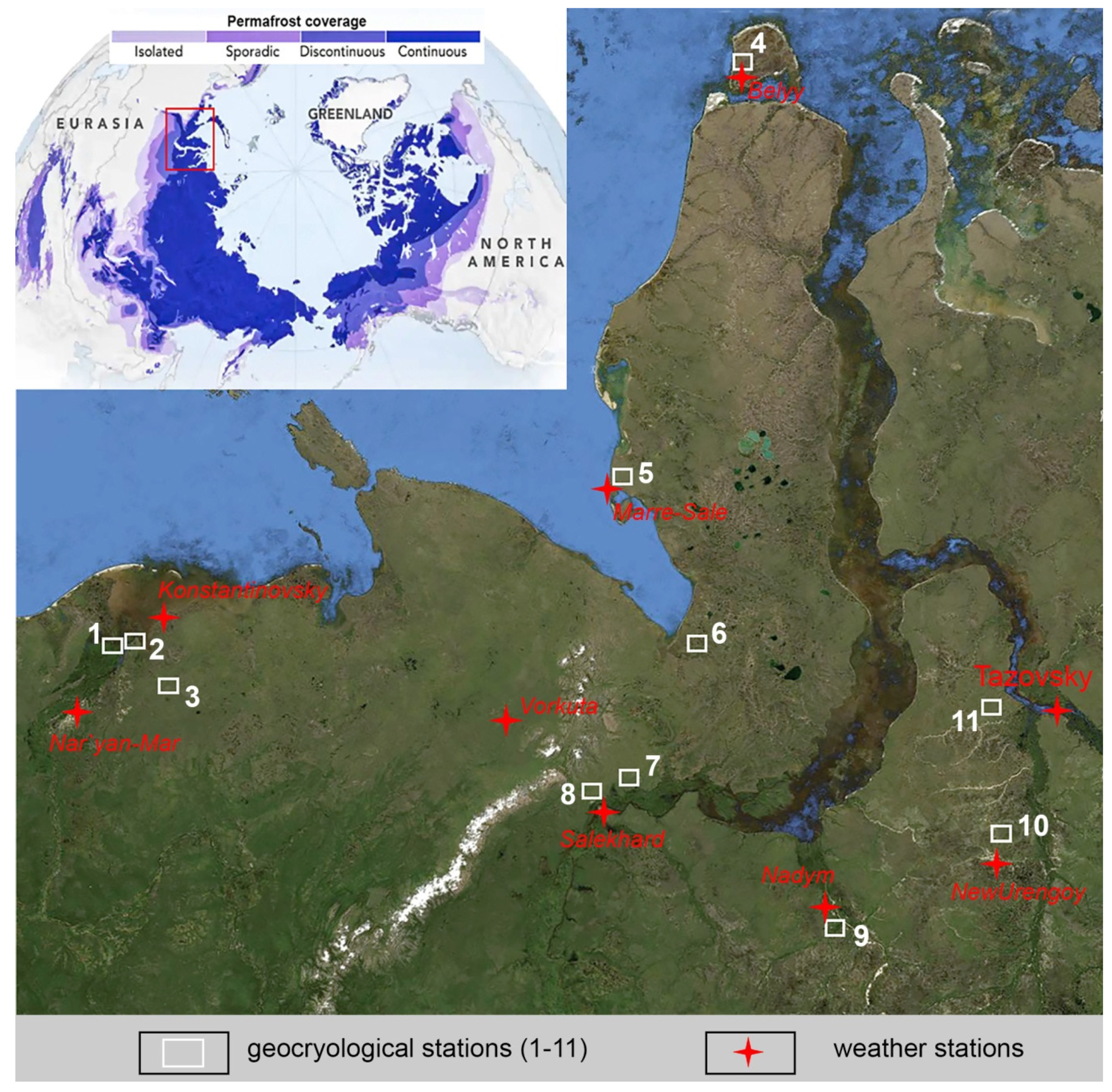

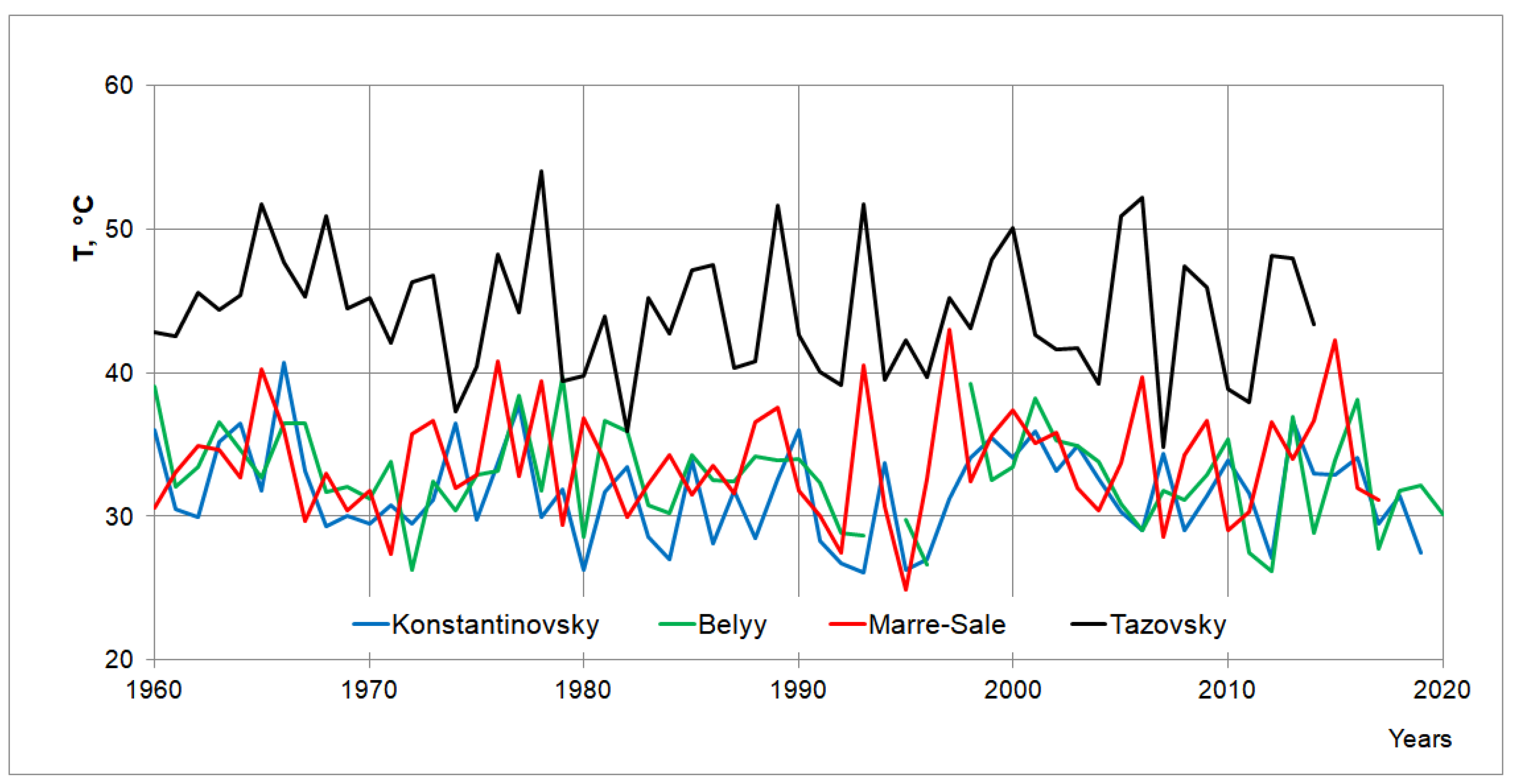
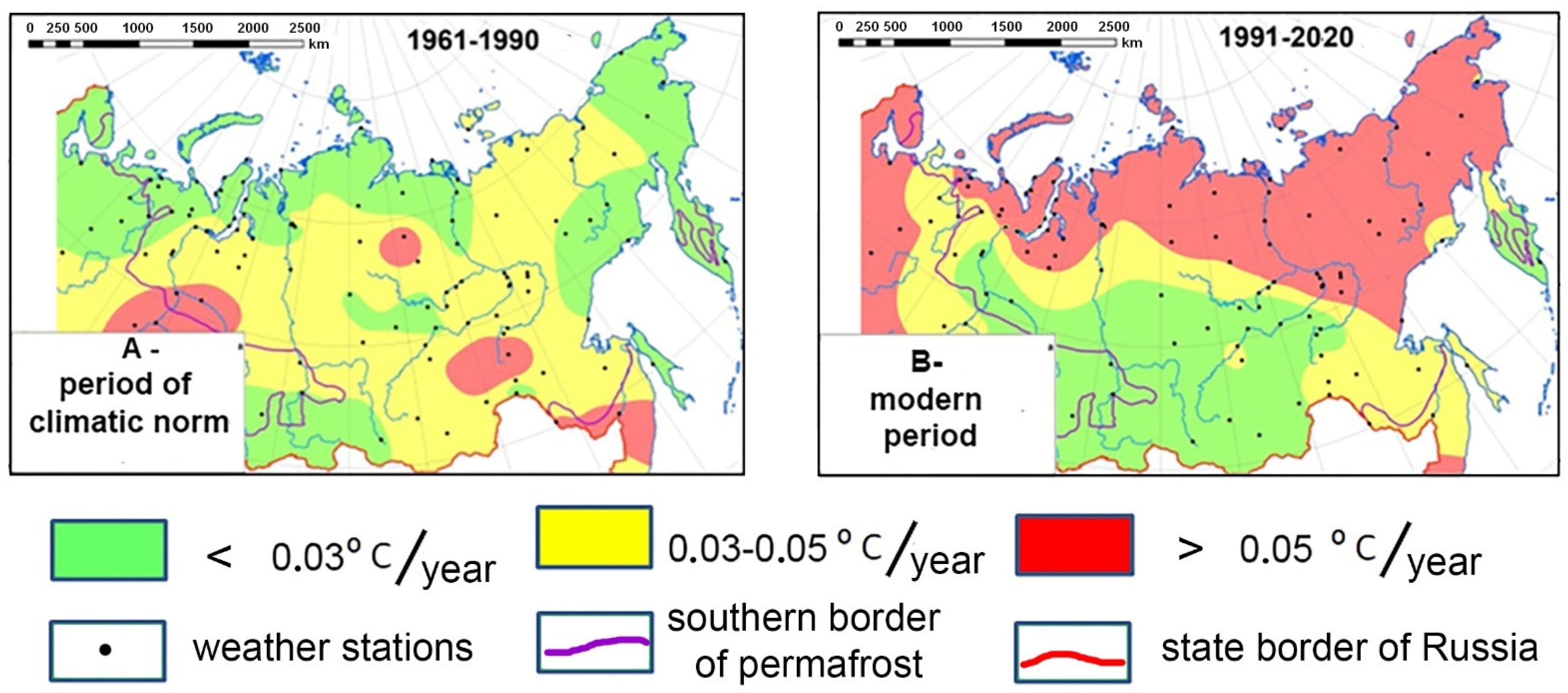
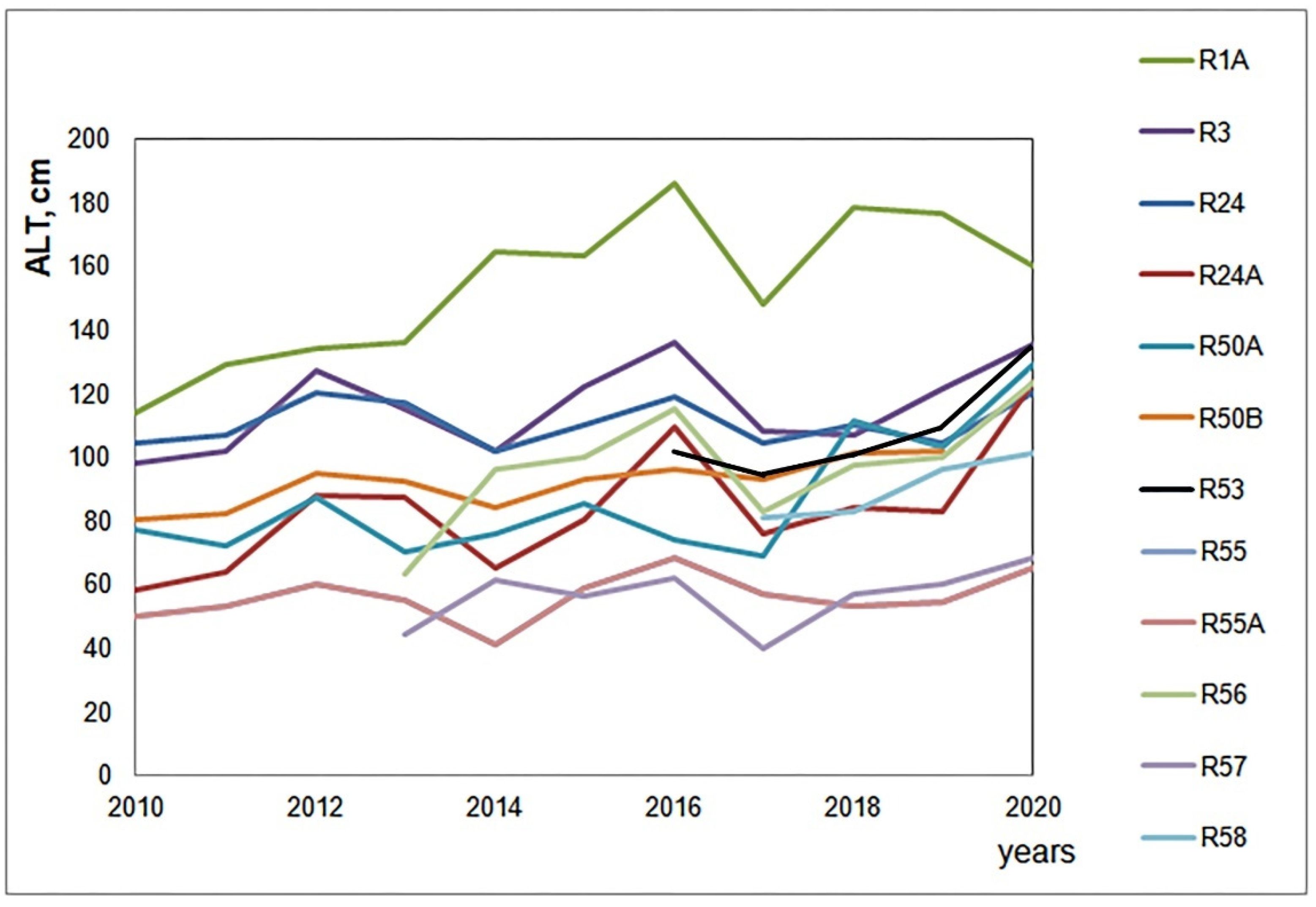


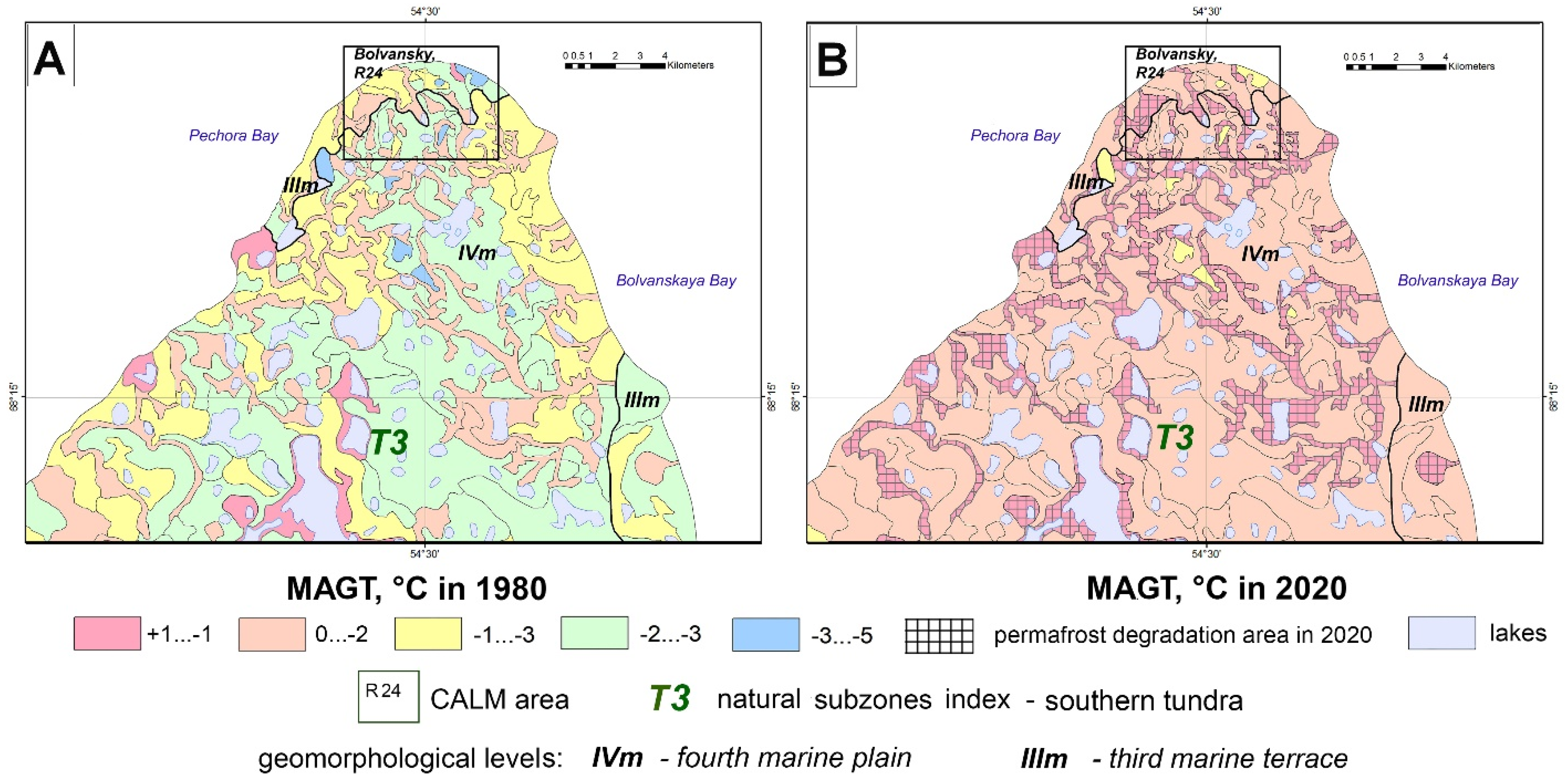
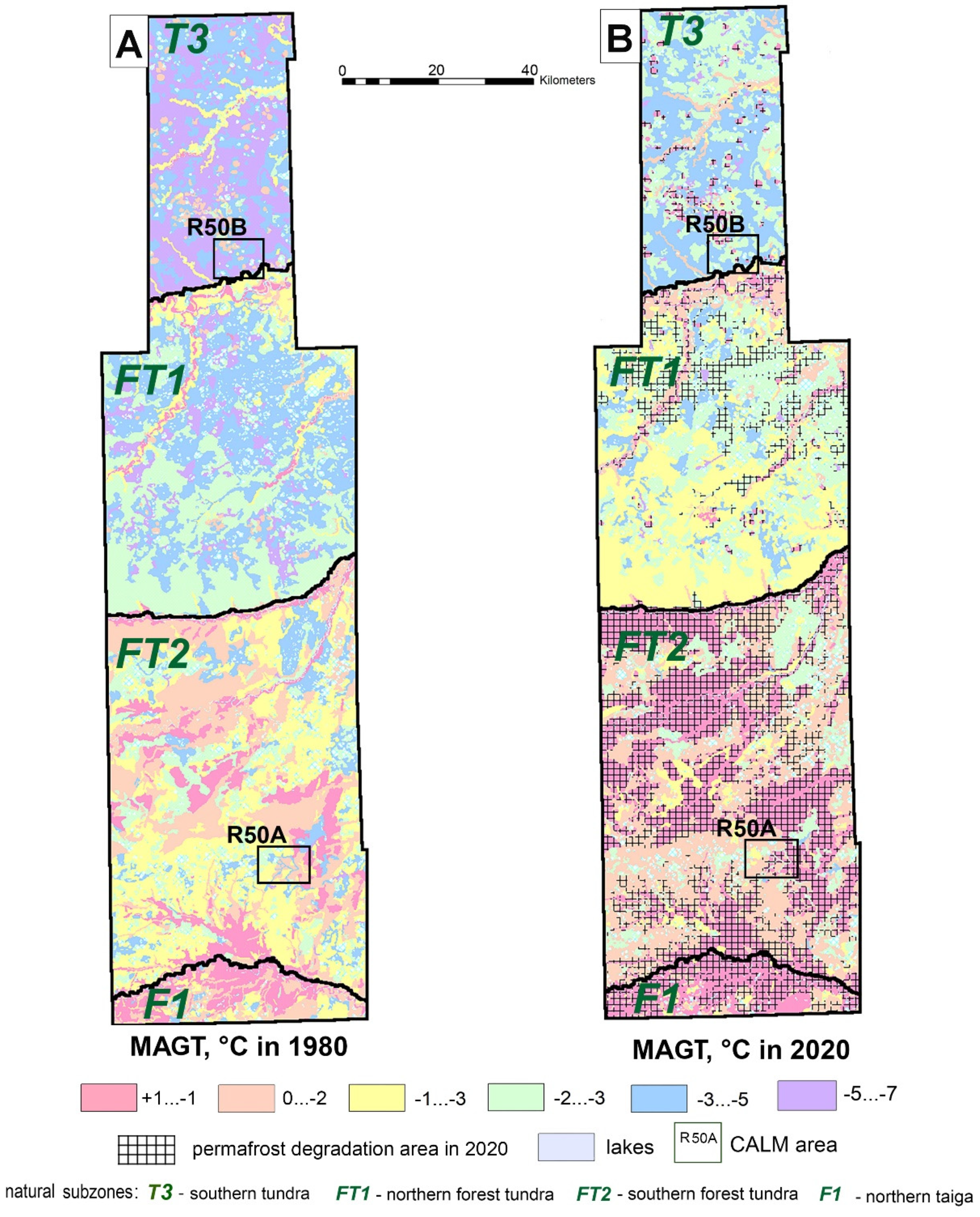
| # In Figure 1 | Operational Stations and Coordinates | Bioclimatic Subzone | Distribution of Permafrost | Number of Boreholes, Observation Period | CALM Sites, Observation Period |
|---|---|---|---|---|---|
| Russian European North | |||||
| 1 | Kashin | Southern tundra | Island | 10 (2012–present) | R24A & R24B (100 × 100 m) (2010–present) |
| N 68°14′ | |||||
| E 53°51′ | |||||
| 2 | Bolvansky | Southern tundra | Continuous | 6 (1983–present) | R24 (100 × 100 m), (1999–present) |
| N 68°17′ | |||||
| E 54°30′ | |||||
| 3 | Shapkino | Southern tundra | Discontinuous | 4 (1983–2019) | - |
| N 67°34′ | |||||
| E 55°07′ | |||||
| Western Siberia | |||||
| 4 | Belyy | Arctic tundra | Continuous | 5 (2009–present) | R55 & R55A |
| N 73°20′ | (100 × 100 m) | ||||
| E 70°05′ | (2009–present) | ||||
| 5 | Marre-Sale | Typical tundra | Continuous | 6 (1978–present) | R3 |
| N 69°43′ | (1000 × 1000 m), | ||||
| E 66°49′ | (1995–present) | ||||
| 6 | Erkuta | Southern tundra | Continuous | - | R58 |
| N 68°15′ | (100 × 100 m), | ||||
| E 69°04′ | (2017–present) | ||||
| 7 | Oktyabrsky | Forest tundra | Discontinuous | - | R57 |
| N 66°58′ | (100 × 100 m), | ||||
| E 67°10′ | (2013–present) | ||||
| 8 | Labytnangy and Harp | Forest tundra | Discontinuous | 3 (1967, 1977, 2021) | R56 & R53 |
| N 66°40′ | (100 × 100 m), | ||||
| E 66°24′ | (2013–present) | ||||
| 9 | Nadymsky | Northern taiga | Island | 15 (1975–present) | R1A & R1B |
| N 65°18′ | (100 × 100 m), | ||||
| E 72°51′ | (1995–present) | ||||
| 10 | Urengoy-South | Forest tundra | Discontinuous | 7 (1975–present) | R50A |
| N 66°19′ | (100 × 100 m) | ||||
| E 76°54 | (2008–present) | ||||
| 11 | Urengoy-North | Southern tundra | Continuous | 7 (1975–present) | R50B |
| N 67°28′ | (100 × 100 m) | ||||
| E 76°42′ | (2008–present) | ||||
| The Name of the Station | Mean Annual Tair, °C MAAT | Freezing Index, °C-Month | Thawing Index, °C-Month | |||
|---|---|---|---|---|---|---|
| 1961–1990 | 1991–2020 | 1961–1990 | 1991–2020 | 1961–1990 | 1991–2020 | |
| Nar’yan-Mar | −3.8 | −2.4 | −83.0 | −72.0 | 37.9 | 43.0 |
| Konstantinovsky | −5.2 | −3.6 | −90.0 | −77.4 | 28.4 | 33.8 |
| Vorkuta | −6.7 | −2.7 | −104.4 | −94.3 | 32.0 | 38.1 |
| Belyy | −11.1 | −9.5 | −145.4 | −129.9 | 10.2 | 15.8 |
| Marre-Sale | −8.5 | −6.9 | −119.7 | −107.4 | 18.4 | 24.3 |
| Salekhard | −5.9 | −4.4 | −113.8 | −101.6 | 42.6 | 48.3 |
| Nadym | −6.0 | −4.5 | −113.8 | −101.8 | 42.6 | 48.7 |
| New Urengoy | −7.3 | −6.1 | ||||
| Tazovsky | −9.2 | −7.4 | −144.1 | −129.5 | 34.3 | 40.8 |
| NN | CALM /Lithology | 2010 | 2011 | 2012 | 2013 | 2014 | 2015 | 2016 | 2017 | 2018 | 2019 | 2020 | Trend in 2010–2020 cm/Year |
|---|---|---|---|---|---|---|---|---|---|---|---|---|---|
| R1A | Nadymsky */peat, sand | 114 | 129 | 134 | 136 | 164 | 163 | 186 | 148 | 178 | 176 | 160 | 6.8 |
| R3 | Marre-Sale/peat, sand | 98 | 102 | 127 | 115 | 102 | 122 | 136 | 108 | 107 | 121 | 135 | 2.0 |
| R24 | Bolvansky */sandy loam | 104 | 107 | 120 | 117 | 102 | 110 | 119 | 104 | 110 | 104 | 120 | 0.3 |
| R24A | Kashin Island/peat, sand | 58 | 64 | 88 | 87 | 65 | 80 | 109 | 76 | 84 | 83 | 123 | 3.7 |
| R50A | Urengoy-south * /peat, sand | 77 | 72 | 87 | 70 | 76 | 85 | 74 | 69 | 111 | 103 | 129 | 4.1 |
| R50B | Urengoy-north * /loam | 80 | 82 | 95 | 92 | 84 | 93 | 96 | 93 | 101 | 102 | 2.1 | |
| R53 | Harp, Polar Urals */loam | 99 | 94 | 100 | 111 | 134 | 8.8 | ||||||
| R55 | Belyy Island /silt loam | 50 | 53 | 60 | 55 | 41 | 59 | 68 | 57 | 53 | 54 | 65 | 0.8 |
| R55A | Belyy Island/sandy | 90 | 98 | 114 | 112 | 91 | 111 | 130 | 115 | 107 | 109 | 131 | 2.5 |
| R56 | Labytnangy /loam | 63 | 96 | 100 | 115 | 83 | 97 | 100 | 123 | 4.7 | |||
| R57 | Oktyabrsky /loam | 44 | 61 | 56 | 62 | 40 | 57 | 60 | 68 | 1.7 | |||
| R58 | Erkuta /peat, sand | 81 | 83 | 96 | 101 | 7.3 |
| Location | Temperature Trend, °C/Year | Kα | |||
|---|---|---|---|---|---|
| αa, Average | αg, Minimum | αg, Maximum | αg, Average | ||
| R1A Nadymsky | 0.08 | 0.001 | 0.027 | 0.009 | 0.11 |
| R3 Marre-Sale | 0.13 | 0.032 | 0.067 | 0.050 | 0.39 |
| R24 Bolvansky | 0.08 | 0.010 | 0.052 | 0.038 | 0.47 |
| R50A Urengoy-South | 0.08 | 0.006 | 0.053 | 0.031 | 0.38 |
| R50B Urengoy-North | 0.10 | 0.008 | 0.074 | 0.050 | 0.47 |
| Labytnangi | 0.06 | 0.004 | 0.017 | 0.011 | 0.18 |
Publisher’s Note: MDPI stays neutral with regard to jurisdictional claims in published maps and institutional affiliations. |
© 2022 by the authors. Licensee MDPI, Basel, Switzerland. This article is an open access article distributed under the terms and conditions of the Creative Commons Attribution (CC BY) license (https://creativecommons.org/licenses/by/4.0/).
Share and Cite
Malkova, G.; Drozdov, D.; Vasiliev, A.; Gravis, A.; Kraev, G.; Korostelev, Y.; Nikitin, K.; Orekhov, P.; Ponomareva, O.; Romanovsky, V.; et al. Spatial and Temporal Variability of Permafrost in the Western Part of the Russian Arctic. Energies 2022, 15, 2311. https://doi.org/10.3390/en15072311
Malkova G, Drozdov D, Vasiliev A, Gravis A, Kraev G, Korostelev Y, Nikitin K, Orekhov P, Ponomareva O, Romanovsky V, et al. Spatial and Temporal Variability of Permafrost in the Western Part of the Russian Arctic. Energies. 2022; 15(7):2311. https://doi.org/10.3390/en15072311
Chicago/Turabian StyleMalkova, Galina, Dmitry Drozdov, Alexander Vasiliev, Andrey Gravis, Gleb Kraev, Yuriy Korostelev, Kirill Nikitin, Pavel Orekhov, Olga Ponomareva, Vladimir Romanovsky, and et al. 2022. "Spatial and Temporal Variability of Permafrost in the Western Part of the Russian Arctic" Energies 15, no. 7: 2311. https://doi.org/10.3390/en15072311
APA StyleMalkova, G., Drozdov, D., Vasiliev, A., Gravis, A., Kraev, G., Korostelev, Y., Nikitin, K., Orekhov, P., Ponomareva, O., Romanovsky, V., Sadurtdinov, M., Shein, A., Skvortsov, A., Sudakova, M., & Tsarev, A. (2022). Spatial and Temporal Variability of Permafrost in the Western Part of the Russian Arctic. Energies, 15(7), 2311. https://doi.org/10.3390/en15072311









